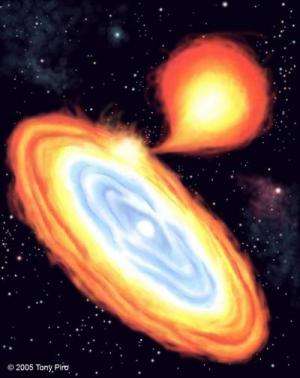Nuclear cooling in neutron stars deepens mystery of hot surface

Research by a team of scientists led by a Michigan State University physicist has shed new light on the properties of neutron stars, super dense stars that form when a large star explodes and collapses into itself.
Writing in the journal Nature, Hendrik Schatz and colleagues describe a newly discovered process that happens within the star's crust, located just below the surface. Until now, scientists thought that nuclear reactions within the crust contributed to the heating of the star's surface.
"We previously thought that these reactions were strong enough to heat up the crust," said Schatz, an MSU professor of physics and astronomy. "But that's not the case."
What the team of scientists found is that in the star's crust near the surface there is a layer where nuclear reactions cause rapid neutrino cooling. Neutrinos are very elementary particles that are created through radioactive decay and pass very quickly through matter.
"These cooling layers are pretty shallow beneath the surface," Schatz said. "If heat from deeper within the star comes up, it hits one of these layers and never makes it to the surface."
Schatz said this discovery produces more questions than answers.
"This completely changes the way we think about the question of the hot surface," he said. "It's a big puzzle now."
On the sub-atomic level, the team found that the process is greatly affected by the shape of the reacting nuclei. "Many nuclei are round and that suppresses the neutrino cooling. In this case, the nuclei are predicted by theorists to be "deformed," more football-shaped", said Sanjib Gupta, a former JINA and LANL (Los Alamos National Laboratory) postdoc, now a faculty member at IIT Ropar in India.
This is also significant as MSU seeks to build the Facility for Rare Isotope Beams. FRIB will be a new U.S. Department of Energy Office of Science national user facility. It is exactly these types of nuclei that researchers could examine in the facility.
This work was enabled by the Joint Institute for Nuclear Astrophysics, or JINA, project that brings together astrophysicists and nuclear physicists to collaborate. JINA is a National Science Foundation Physics Frontiers Center on Nuclear Astrophysics. MSU is one of the core institutions of JINA, which was founded in 2003.
More information: Strong neutrino cooling by cycles of electron capture and betta(-) decay in neutron star crusts, Nature, dx.doi.org/10.1038/nature12757
Journal information: Nature
Provided by Michigan State University



















